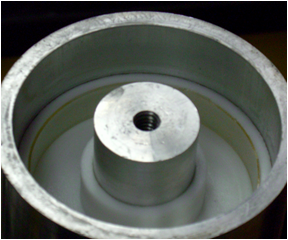This procedure describes the preparation of spin-cast side chain LCE developed in Heino Finkelmann's lab. The total preparation for the material is approximately 48 hours. The image to the right shows an LCE film at the end of the spin casting process.


| Chemical | CAS # |
| mesogen | |
| crosslinker | |
| platinum catalyst (COD) | |
| methyl-hydrosiloxane | |
| Toluene | [65-45-3] |
| De-ionized H2O |





 If the material is still a liquid inside the spin casting head, add a few
uL of catalyst solution, and spin for an additional 30 to 40 minutes.
If the material is still a liquid inside the spin casting head, add a few
uL of catalyst solution, and spin for an additional 30 to 40 minutes.


 (see image gallery for more images)
(see image gallery for more images)